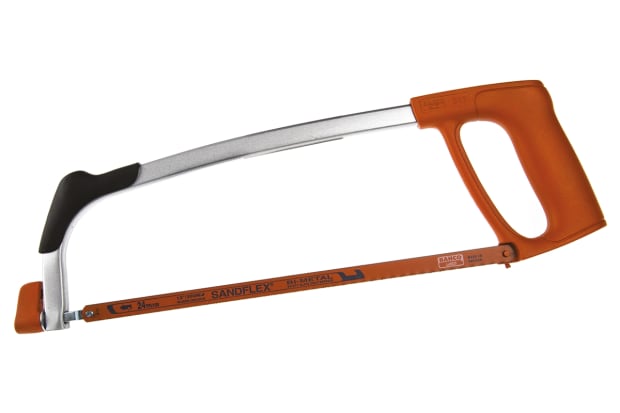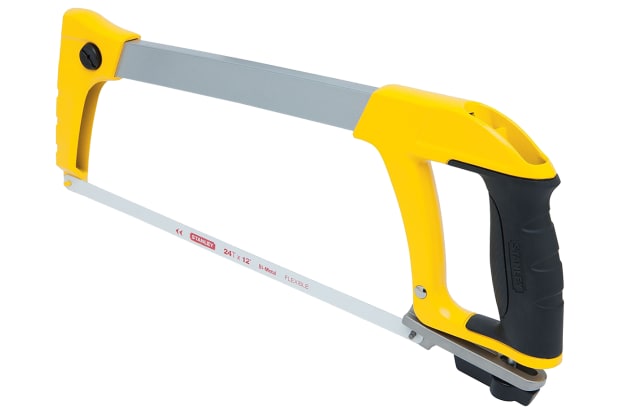- Published 20 Aug 2024
- Last Modified 20 Aug 2024
- 9 min
Everything You Need to Know About Hacksaws

Discover everything about hacksaws in this guide, from understanding their components and uses to learning about safety practices and exploring the different types and brands available in the market.
What is a Hacksaw?
A hacksaw is a specialised hand tool designed for cutting through various materials, including plastic, steel, and other metals. Unlike traditional hand saws that are primarily used for wood, hacksaws are essential tools for both professionals and DIY enthusiasts. Their design allows for efficient and precise cutting, making them invaluable in various applications, from plumbing to metalworking.
Hacksaws deliver reliable cutting power, making them suitable for a wide range of projects. They are characterised by their unique adjustable frame, which resembles the letter ‘D’. This frame holds the blade under tension, allowing for controlled and accurate cuts. The ability to adjust the frame also enables users to accommodate different blade sizes, enhancing the tool's versatility.
Parts of a Hacksaw
Hacksaw Frames
The hacksaw frame, often referred to as the blade holder, is a critical component of the tool. It typically features an ergonomic handle, such as a pistol grip, which provides comfort during use. The frame is constructed from durable materials like steel or aluminium and includes pins for securely attaching new blades. Many frames are adjustable, allowing users to switch between various blade lengths easily.
Hacksaw Blades
Hacksaw blades come in various sizes and teeth configurations to suit different cutting needs. The most common length for hacksaw blades is 12 inches (300mm), although they can be as short as six inches (150mm) for more compact applications. Blades are mounted onto the hacksaw frame using pins that fit into holes at either end of the blade. The spacing of these holes determines the blade's length and suitability for specific tasks.
The teeth per inch (TPI) of hacksaw blades can vary significantly, with options ranging from 14 to 32 TPI for finer cuts. Selecting the right blade is crucial, as it directly impacts the efficiency and quality of the cut, especially when working with different materials.
Typical Hacksaw Uses
Hacksaws are widely used by professionals in various fields, including plumbing, electrical work, and automotive repair. Their versatility makes them a go-to tool for a variety of cutting tasks. Some of the most common applications for hacksaws include:
- Cutting pipes for plumbing installations
- Shaping and trimming metal sheets for fabrication
- Slicing through plastic materials for construction or repair projects
In addition to these uses, hacksaws are also employed in crafting and hobby projects, where precision cutting is essential. Their ability to handle both soft and hard materials makes them an indispensable tool in any workshop.
Types of Hacksaws
Hacksaws come in various shapes, sizes, and designs to accommodate different cutting needs and applications. Here are the main types of hacksaws:
Full-Sized Hacksaws
Also known as senior hacksaws, full-sized hacksaws are large, versatile tools that are straightforward to operate and can efficiently cut through tough materials. They are compatible with a range of blade types, including 12, 18, 24, and 32 teeth per inch (TPI) blades. Full-sized hacksaws are ideal for heavy-duty cutting tasks in workshops, construction sites, and industrial settings.
Junior Hacksaws
Junior hacksaws are a smaller variant used when space is limited or more precise cutting is required. They feature softer, half-sized blades and are not suitable for cutting harder substances. Junior hacksaws are compact, easily portable hand tools that excel in tight spaces and are often used for plumbing, electrical work, and DIY projects.
Mini Hacksaws
Mini hacksaws are lightweight and compact models designed for cutting in particularly confined spaces and accessing hard-to-reach areas, such as domestic pipework. They typically feature long, ergonomic handles and highly compact D-shaped frames, making them ideal for precision work in tight quarters.
Power Hacksaws
Power hacksaws, also known as electric hacksaws, are typically stationary devices that feature built-in electric motors to power their blades. They can also be attached to separate motors or engines. Power hacksaws normally automatically elevate their blades on the return stroke, and some handheld models are also available. Coolant pumps are another common inclusion to help prevent the blades from overheating during use.
Explore the Different Hacksaw Types
This video shows some of the different types of hacksaws in greater detail. It offers a useful glimpse into what is available as well as explaining the best uses and applications for each type of saw. From adjustable hacksaws to close-quarters hacksaws, this video provides a handy visual guide to help you choose the best hacksaw for your requirements.
Safety Tips for Using a Hacksaw Effectively
Using a hacksaw safely is crucial for preventing accidents and ensuring effective cutting. Like any tool, it requires focus and attention to detail. Here are some essential tips to help you use a hacksaw safely and efficiently:
- Choose the Right Blade: Selecting the appropriate blade for the material you are cutting is vital. Different materials require blades with varying teeth per inch (TPI), so ensure you have the right one for your task.
- Check Blade Orientation: Always ensure the blade is mounted in the correct direction, with the teeth facing forward. This orientation allows for effective cutting on the forward stroke.
- Secure the Blade Properly: Before starting, double-check that the blade is firmly secured to the frame. A loose blade can lead to inaccurate cuts and may snap during use.
- Stabilise the Workpiece: Always secure the object you are cutting using a vice or clamps. This prevents movement and allows for cleaner, safer cuts.
- Direct Cutting Movements Away from Your Body: When sawing, maintain a firm grip and direct the cutting movements away from your body to minimise the risk of injury.
How to Change a Hacksaw Blade
Changing a hacksaw blade is a simple process that can be completed in a few easy steps, regardless of whether you are using a senior or junior model. Follow this step-by-step guide:
- Loosen the Current Blade: Depending on your hacksaw model, either apply the fasten-release mechanism or turn the wing nut to loosen the existing blade.
- Remove the Old Blade: Carefully slide out the current blade from the frame.
- Insert the New Blade: Place the new blade onto the retaining pins within the handle, ensuring it is oriented correctly.
- Secure the Blade: Tighten the wing nut or reapply the fasten-release mechanism to secure the blade in place.
- Test the New Blade: Conduct a test cut on a piece of scrap material to ensure the new blade is properly installed and safe to use.
How to Maintain a Hacksaw
Regular maintenance of your hacksaw is essential for ensuring optimal performance and safety. Here are some key maintenance tips to keep your hacksaw in excellent condition:
- Inspect Blades Regularly: Frequently check hacksaw blades for signs of damage, such as warping or dullness. If you notice any wear and tear, replace the blade immediately.
- Lubricate the Blade: Applying oil or lubricant to the blade can help reduce friction and overheating during cutting, prolonging the life of the blade.
- Cut Slowly with Hard Materials: When cutting harder materials, reduce the speed to minimize the risk of blade breakage. This approach allows for better control and cleaner cuts.
- Clean the Blades: Regularly clean the blades to remove debris and prevent rust, ensuring they remain in good condition for longer.
- Store Properly: When not in use, store your hacksaw in a dry place and consider using a blade cover to protect the blade from damage.
Popular Hacksaw Brands
Many different brands and manufacturers supply hacksaws, each best suited to varying applications. The following are just a few examples of popular brands:
RS PRO
Our in-house brand, RS PRO, offers multiple types of hacksaws, each ideal for varying applications. Shop now!
Bahco
Bahco is a leading brand offering high-quality hacksaws suitable for multiple uses. Explore the full range today.
Stanley
Commonly used by both hobbyists and professionals alike, Stanley hacksaws remain a popular choice. Shop the full range online now.



